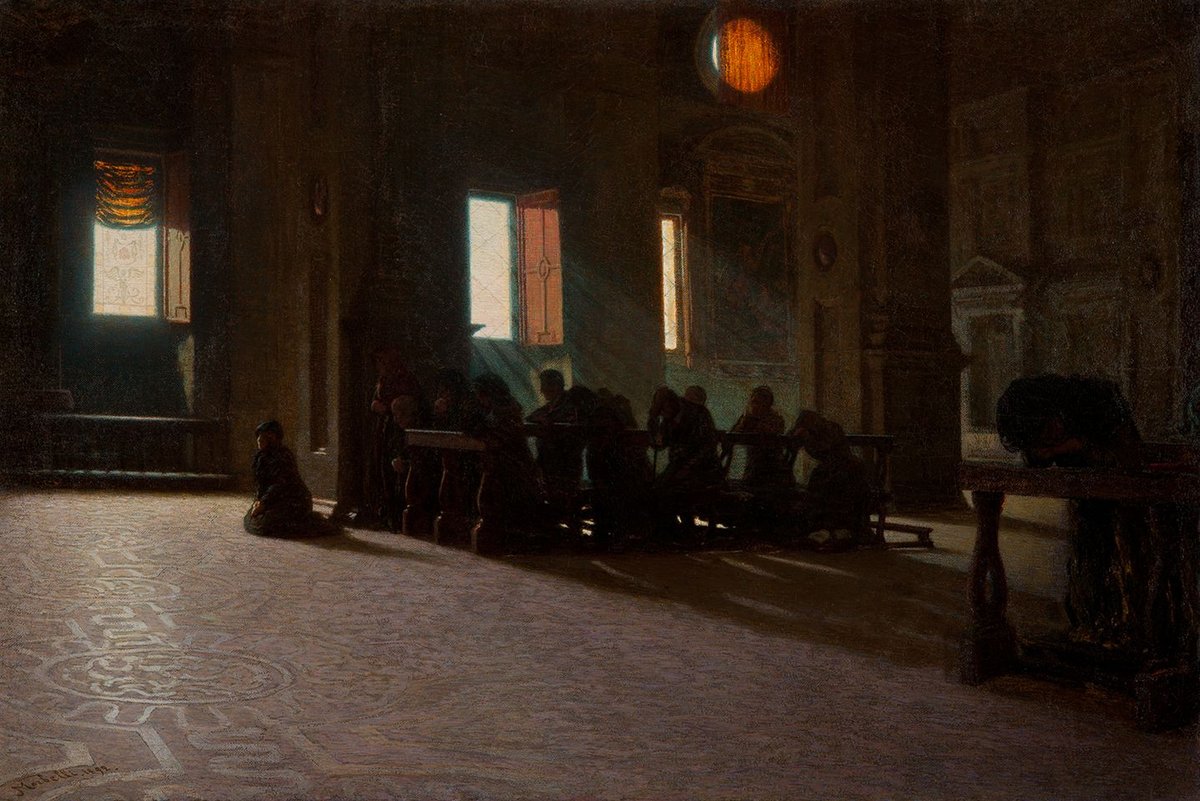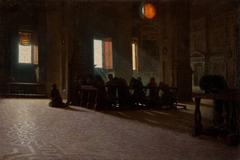
Santa Maria presso San Celso Church, Milan: Visiting Hours, Tickets, and Historical Significance
Date: 14/06/2025
Introduction
Santa Maria presso San Celso is one of Milan’s most treasured religious and historical landmarks, celebrated for its architectural grandeur, miraculous origins, and vibrant role in the city’s spiritual life. Built on centuries-old Christian foundations and intimately linked with the veneration of Saint Celsus and the Virgin Mary, this sanctuary offers visitors a unique window into Milan’s artistic, cultural, and religious evolution. Whether you are an art enthusiast, a pilgrim, or a traveler eager to explore Milan’s storied past, this guide provides all the practical and historical information you need to experience Santa Maria presso San Celso fully and respectfully (Chiesa di Milano; In Lombardia; Conceptual Fine Arts).
Contents
- Origins and Miraculous History
- Architectural Evolution
- Religious and Cultural Significance
- Artistic Highlights
- Visiting Information
- Opening Hours & Admission
- Accessibility
- Guided Tours
- How to Get There
- Visitor Etiquette & Photography
- Facilities
- Frequently Asked Questions (FAQ)
- Tips for Visitors
- Conclusion
- Sources
Origins and Miraculous History
Santa Maria presso San Celso stands on a site sacred since the 4th century, when Saint Ambrose established a chapel for the relics of Saint Celsus and adorned it with an image of the Virgin Mary (Conceptual Fine Arts). The church’s enduring fame, however, stems from the miraculous event of December 30, 1485: as Milan was ravaged by plague, witnesses reported that the Madonna’s image became animated, lifting her veil and gazing upon the congregation. This event was interpreted as a sign of divine intervention, and the plague soon subsided (Chiesa di Milano). In gratitude, the citizens of Milan began constructing the present sanctuary in 1493, beside the older Basilica of San Celso.
Over the centuries, the site has attracted pilgrims seeking healing and intercession, and it remains a focal point for Marian devotion—especially during the annual commemoration of the miracle on December 30.
Architectural Evolution
Renaissance Beginnings and Baroque Flourish
The sanctuary’s design reflects the evolution of Milanese architecture from Renaissance balance to Baroque exuberance. Giovanni Battagio’s initial plans emphasized harmonious proportions and classical motifs, with an octagonal dome and marble façade that exemplify the Lombard Renaissance style. The church’s façade, completed in the early 17th century by Galeazzo Alessi and Martino Bassi, is a masterpiece of Baroque design, featuring a grand portico with Corinthian columns, statues, and intricate reliefs (In Lombardia).
Within, the Latin cross plan, side chapels, and presbytery create a luminous space crowned by Giovanni Antonio Amadeo’s dome, adorned with frescoes and stuccoes that guide the visitor’s gaze upward.
Connection to the Basilica of San Celso
Santa Maria is physically connected to the ancient Romanesque Basilica of San Celso via a portico, symbolizing the continuity of Christian worship on the site and offering visitors a journey through centuries of sacred architecture.
Religious and Cultural Significance
Since its miraculous origins, Santa Maria presso San Celso has served as a destination for pilgrims and a locus of Marian devotion. The sanctuary is adorned with ex-votos, testimonies of answered prayers, and hosts annual processions and liturgical celebrations commemorating the 1485 miracle (Chiesa di Milano).
A beloved Milanese tradition involves newlywed brides bringing bouquets to the Madonna, seeking blessings for their marriage (Milano da Vedere). The church’s designation as a “chiesa giubilare” (jubilee church) in 2025 underscores its enduring importance in Milan’s religious landscape.
Artistic Highlights
Santa Maria presso San Celso boasts a remarkable collection of Renaissance and Baroque artworks:
- The Miraculous Madonna: The venerated icon above the high altar is unveiled on special occasions and forms the heart of Marian devotion (Conceptual Fine Arts).
- Frescoes & Altarpieces: Works by Camillo Procaccini, Bernardino Luini, Carlo Urbino, Gaudenzio Ferrari, Paris Bordone, and others adorn the chapels and nave (Milano da Vedere).
- The Weeping Madonna Fresco: A 14th-century fresco that reportedly wept during the plague of 1620—a testament to the sanctuary’s role in Milan’s spiritual resilience (In Lombardia).
- Crucifix of San Carlo Borromeo: Carried by the saint during the 1576 plague, this relic is a symbol of hope and endurance.
Visiting Information
Opening Hours (June 2025)
- Monday to Saturday: 7:00 am – 12:45 pm; 4:00 pm – 7:30 pm
- Sunday: 8:30 am – 1:00 pm; 4:00 pm – 8:00 pm
(Please check the official website for updates during holidays and special events.)
Admission
- Entry is free of charge. Donations are welcome and support ongoing maintenance and restoration (TripHobo).
Mass Schedule
- Monday to Friday: 7:30 am, 9:00 am, 6:00 pm
- Thursday: Additional Mass at 1:15 pm
- Saturday: 9:00 am, 6:30 pm
- Sunday: 9:00 am, 11:00 am, 12:15 pm, 7:00 pm
(Full details at church website)
Accessibility
- The sanctuary is wheelchair accessible via ramps at the main entrance, though some historic areas may have steps or uneven flooring.
- For additional assistance, contact the church or your tour provider in advance.
Guided Tours
- Guided tours (in English and Italian) are available through local agencies like Milanoguida and Scoprire Milano.
- Tours offer expert insights into the sanctuary’s history, miracles, and art.
How to Get There
- Address: Corso Italia, 37, 20122 Milano MI, Italy
- Metro: Missori (Line 3, Yellow), a short walk from the church
- Train: Milano Centrale is approx. 2 km away; connect via Metro or taxi
- Air: Milan Linate (7 km), Malpensa (50 km); both connected by shuttle and public transport
- Car/Bus: Accessible via Corso Italia; public parking available nearby, but public transport is recommended for convenience (Christian Directory)
Visitor Etiquette & Photography
- Modest attire is required (shoulders and knees covered; hats removed).
- Silence is appreciated, especially during services.
- Photography is permitted, but no flash or tripods, and always respect signs or staff instructions.
Facilities
- No on-site parking; use public transport or nearby garages.
- Restrooms are not available inside; use nearby cafés or public facilities.
- No cafés or shops within the church, but plenty of amenities nearby due to the central location.
Frequently Asked Questions (FAQ)
Q: Is there an admission fee?
A: No, entry is free; donations are encouraged.
Q: What are the opening hours?
A: Monday–Saturday, 7:00 am–12:45 pm & 4:00 pm–7:30 pm; Sunday, 8:30 am–1:00 pm & 4:00 pm–8:00 pm.
Q: Are guided tours available?
A: Yes, through local agencies and by arrangement in advance.
Q: Is the church wheelchair accessible?
A: Main spaces are accessible; some historic areas may be challenging.
Q: Can I take photos inside?
A: Yes, but without flash or tripods and not during services.
Q: How long should I plan to visit?
A: 30–60 minutes is typical; guided tours may last longer.
Q: When is the best time to visit?
A: Early morning or late afternoon for quieter visits; feast days and Sundays are busier.
Tips for Visitors
- Check the official website before your visit for any changes to hours or service schedules.
- Combine your visit with nearby landmarks such as Sforza Castle and Santa Maria delle Grazie.
- Download the Audiala app for guided audio tours and up-to-date visitor tips.
- Respect the sacred atmosphere and local traditions—especially during liturgical events.
Conclusion
Santa Maria presso San Celso is more than a historical monument—it is a living center of faith, art, and Milanese tradition. From its miraculous origins and Renaissance-Baroque architecture to its rich collection of devotional art and ongoing role in the community, the sanctuary offers an immersive experience for all who enter its doors. With free admission, accessible facilities, and proximity to other major attractions, it is an essential stop on any cultural or spiritual itinerary in Milan. Visit, reflect, and discover the enduring legacy of this extraordinary sanctuary.
Sources
- Santa Maria dei Miracoli: una festa giubilare, 2025, Chiesa di Milano (Chiesa di Milano)
- Santuario Santa Maria dei Miracoli presso San Celso, 2025, In Lombardia (In Lombardia)
- Weekend Tips: The Miracle of Santa Maria presso San Celso in Milan, 2015, Conceptual Fine Arts (Conceptual Fine Arts)
- Santa Maria presso San Celso Milan Visitor Information, 2025, Christian Directory (Christian Directory)
- Santa Maria presso San Celso Visitor Guide, 2025, TripHobo (TripHobo)




























































